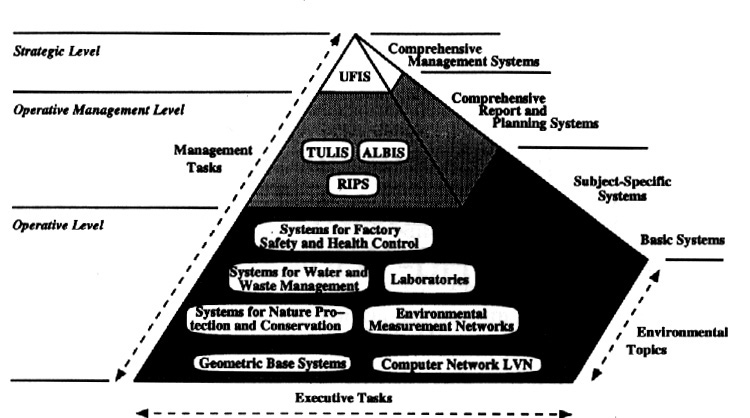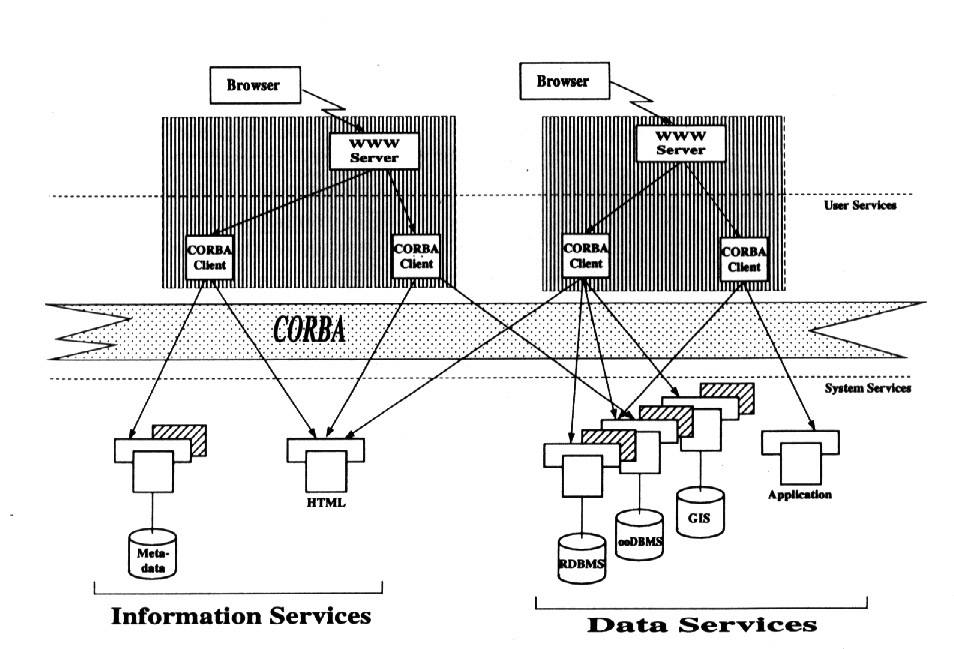
Ralf Kramer, Forschungszentrum Informatik (FZI), Karlsruhe
Horst Spandl, Landesanstalt für Umweltschutz (LfU), Stuttgart
As an example for such a system, Figure 1 illustrates the concept of the environmental information system UIS Baden-Wuerttemberg, Germany [Mayer-Föll 93]. In a three layer architecture, systems are organized hierarchically and vertically.
The remainder of this paper is organized as follows. In Section 2 we focus on making databases available on the World-Wide Web using the current standard access technique, the so-called common gateway interface CGI. In Section 3 , we show how World-Wide Web techniques can be combined with further standards and hence, how advanced functionalities can be provided. Section 4 concludes the paper with some final remarks.

Figure 1: The Component Categories within the Environmental Information System (UIS), Baden-Württemberg, Germany
An important issue in the Word-Wide Web as in any hypermedia system is to identify and to find relevant data sources that are likely to answer a certain query. Within the Web, various search engines like Yahoo, Lycos or Altavista have taken on the task to provide a searchable index of available HTML documents. Unfortunately, these systems can only catalogue static HTML pages.Dynamically generated HTML, which is typical for database access through the CGI interface, is beyond the capabilities of these indexing programs, so-called web-crawlers or web-robots. An additional difficulty creeps in from the semantic dimension of the problem as most web-robots rely on information available in the indexed HTML document itself, typically the <TITLE> of the document in the header section. The quality of the descriptions depends on the individual effort of the information providers. However, it is impossible to apply a common glossary throughout the world!
At FZI, work in this area started as early as 1994 [Kramer 95, Kramer 96a] under contract of the Ministry of Environment Baden-Wuerttemberg, Germany. The environmental data catalogue UDK has been made available as an online database via the common gateway interface. The Austrian version, which is already available to the public (URL: http://udk.bmu.gv.at), features both German and English query and result forms. A special feature of the version for Baden-Wörttemberg, Germany, is the online access to underlying data sources like further databases and environmental reports. Furthermore, access from and to a geographic information system is available in a first prototype [Koschel 96, Kramer 96b]. A deliberate attempt has been made to add the additional functionality with the least extensions to the underlying UDK data model as possible. All of these databases have been made available using the standard common gateway interface at the WWW server site.
On the other hand, when compared to classical client/server database tools, WWW poses some problems. One of these problems is that WWW only supports access to a single data source at a time, i.e., if, in order to answer a certain query, several data servers have to be accessed, the user has to access all of them in turn explicitely. He or she has to combine the individual results, which are presented on individual result pages, manually. Another severe limitation is that the hypertext transfer protocoll (HTTP) does not support more complex interactions with database systems, so-called database transactions. Hence, especially database transactions that access and modify more than one database relation are extremely difficult, if at all, to implement. The connection-less communication model of HTTP (re-)imposes restrictions on the user interface. Common techniques such as context-sensitive list of values or pop-up menus are currently out of reach of the current WWW standards.

Figure 2: A Sotware Architecture incorporating the World-Wide Web and COBRA
Horizontally, we distinguish between application level and system level services.System level services provide basic functionality such as accessing databases and preparing HTML pages. Application level services basically combine several system level services into higher level services that are available for the user. Using CORBA, these services can be transparently assigned to computers in a network.
Vertically, we distinguish between information and data services. Information services help the user to find relevant data sources, e.g., data services and environmental reports. They are based on the environmental data catalogue UDK, which has been extended in order to provide online access to data services as described in Section 2.2 and shown in Figure 2. These data sources primarily are environmental databases and reports that are as well accessible with WWW tools. Data sources may comprise geographic information systems (GIS), relational, pre-relational, object-oriented database systems, and expert systems.
The third problem of using more context-sensitive presentation techniques within the user interface can be approached using JAVA or JAVAScript, a scripting extension to HTML introduced by the latest Netscape versions. Unfortunately, in sharp contrast to JAVA, JAVAScript still lacks important security features and the strict definition as a standard. Hence, at least currently, using JAVAScript cannot be recommended.
Acknowledgements: The first author would like to thank his colleagues at FZI, Arne Koschel and Ralf Nikolai, for the stimulating discussions and inspiring work atmosphere, Rudolf Legat and Dr. Konrad Zirm at the Austrian Federal Ministry of Envrironment, and Bernhard Lorenz at ISEP, Vienna, Austria. It has been a pleasure to collaborate with Manfred Mueller and his colleagues at the Landesanstalt fuer Umweltschutz Baden-Wuerttemberg, Karlsruhe, Germany, and with Dr. Joachim Wiesel and Wilhelm Hagg, Institute of Photogrammetry and Remote Sensing, University of Karlsruhe, Germany.
[Computing 96] PostModern Computing. Blackwidow information. URL http://www.pomoco.com/BW/reference_manual.html, 1996.
[Huber-Wäschle 95] F.Huber-Wäschle, H. Schauer, P. Widmayer, editors. Herausforderungen eines globalen Informationsverbundes für die Informatik; 25. GI-Jahrestagung und 13. Schweizer Informatikertag, Zürich, 18.-20. September 1995/GISI 95, Informatik Aktuell. Springer, 1995.
[Koschel 95a] A Koschel, R. Kramer, R. Nikolai. Architektur des WWW- und CORBA-basierten UIS. In R. Mayer-Föll, A. Jäschke, editors, Projekt GLOBUS; Konzeption und prototypische Realisierung einer aktiven Auskunftskomponente för globale Umwelt-Sachdaten im Umweltinformationssystems Baden-Wörttemberg; Phase II 1995, number FZKA 5700 in Wissenschaftliche Berichte, pages 39-45. Forschungszentrum Karlsruhe Technik und Umwelt, Karlsruhe, Dec. 1995.
[Koschel 95b] A. Koschel, R. Kramer, D. Theobald. CORBA-Evaluierung för das UIS Baden-Wörttemberg}. In R. Mayer-Föll, A. Jäschke, editors, Projekt GLOBUS; Konzeption und prototypische Realisierung einer aktiven Auskunftskomponente für globale Umwelt-Sachdaten im Umweltinformationssystems Baden-Wörttemberg; Phase II 1995, number FZKA 5700 in Wissenschaftliche Berichte, pages 47-92. Forschungszentrum Karlsruhe Technik und Umwelt, Karlsruhe, Dec. 1995.
[Koschel 96] A. Koschel, R. Kramer, R. Nikolai, W. Hagg, J. Wiesel. A Federation Architecture for an Environmental Information System incorporating GIS, the World-Wide Web, and CORBA.In Third International Conference/Workshop Integrating GIS and Environmental Modeling, Santa Fe, New Mexico, USA, Jan. 1996.
[Kramer 95] R. Kramer, H. Spandl. Metadatenzugriff in Weitverkehrsnetzen: Eine Realisierung am Beispiel des Umweltdatenkatalogs UDK. In Huber-Wäschle etal. [Huber-Wäschle 95], pages 610-617.
[Kramer 96a] R. Kramer, T. Quellenberg. Global Access to Environmental Information. In R.Denzer, D.Russel, G.Schimak, editors, Environmental Software Systems; Proceedings of the International Symposium on Environmental Software Systems, 1995, International Federation for Information Processing (IFIP), pages 209 - 218, London, 1996. Chapman and Hall.
[Kramer 96b] Ralf Kramer, Ralf Nikolai, Andree Keitel, Rudolf Legat, Konrad Zirm. Enhancing the Environmental Data Catalogue UDK for the World Wide Web. In 10. Symposium Informatik für den Umweltschutz, Sept. 1996. to appear.
[Lessing 95] H. Lessing, O. Gönther, W. Swoboda. Ein objektorientiertes Klassenkonzept för den Umweltdatankatalog (UDK). In H. Kremers, W. Pillmann, editors, Raum und Zeit in Umweltinformationssystemen; Space and Time in Environmental Information Systems; 9th International Symposium Computer Science for Environmental Protection CSEP'95, number~7 in Umwelt-Informatik Aktuell, pages 391-399, Marburg, 1995. Metropolis.
[Mayer-Föll 93] R. Mayer-Föll. Das Umweltinformationssystems Baden-Wörttemberg - Zielsetzung und Stand der Realisierung. In A. Jäschke, T. Kämpke, B. Page, F.J. Radermacher, editors, Informatik för den Umweltschutz, Proceedings 7. Symposium GI-FA 4.6, pages 313-337, Berlin Heidelberg, 1993. Springer.
[Object Management Group 95] Object Management Group. The Common Object Request Broker: Architecture and Specification, Version 2.0. (OMG) Document, Object Management Group, Inc. (OMG), July 1995.
[Swoboda 95] W. Swoboda, H. Lessing, P. Grolimund, O. Gönther, U. Haas, R. Legat, M. Vogler, K. Zirm. Metadatenklassen im Umweltdatankatalog (UDK). In Huber-Wäschle etal. [Huber-Wäschle 95], pages 601-609.